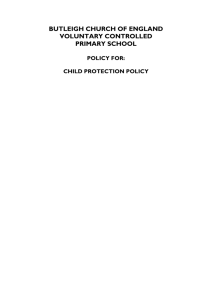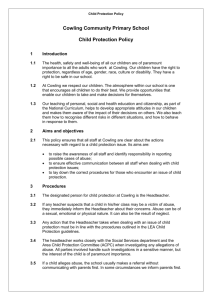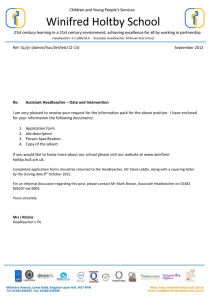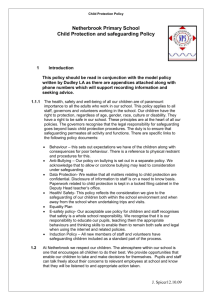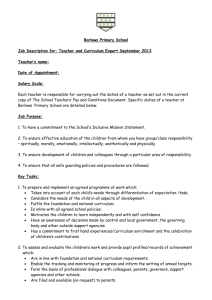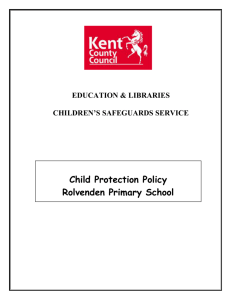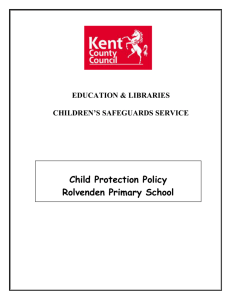Child Protection Policy - St. Clare`s Catholic Primary School
advertisement
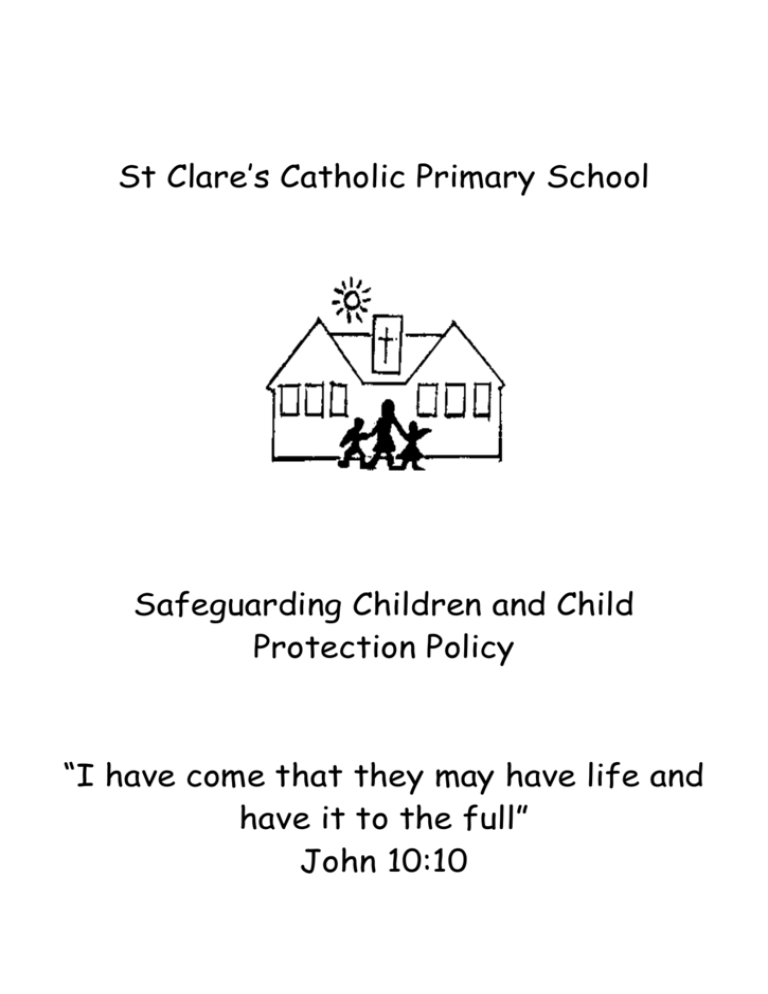
St Clare’s Catholic Primary School Safeguarding Children and Child Protection Policy “I have come that they may have life and have it to the full” John 10:10 This policy is written in line with the recommendations made in the Lauren Wright inquiry report and section 175 of the 2002 Education act to ‘safeguard and promote’ the welfare of the pupils’. It is reviewed by the full governors on an annual basis to ensure the effective management of child protection and to comply with any legislative changes. The health, safety and well-being of all our children are of paramount importance to all the adults who work in our school. Our children have the right to protection, regardless of age, gender, race, culture or disability. They have a right to be safe in our school. In our school we respect our children. The atmosphere within our school is one that encourages all children to do their best. We provide opportunities that enable our children to take and make decisions for themselves. Our teaching of personal, social and health education and citizenship, as part of the National Curriculum, helps to develop appropriate attitudes in our children and makes them aware of the impact of their decisions on others. We also teach them how to recognise different risks in different situations, and how to behave in response to them. Child Abuse: Staff must be vigilant and aware of the design of child abuse, which can include: Physical: Non-accidental injury - bruises, pressure marks, breakages, scalds, burns, bite marks, cuts. Neglect: Dirty, clothes not washed/changed, uncared for. Underweight/underfed: Failure to thrive - malnutrition. Emotional: Severe behavioral problems, withdrawn, frightened. Sexual: Physical signs not always apparent (only on examination), child may hint/tell someone. Child abuse is an offence. It must be reported. Be suspicious and report all concerns to the named person for child protection (the Headteacher) immediately. Don’t hesitate if unsure, the interests of the child are paramount. Children are more at risk from within the family than from outside. Page 2 of 6 Highest Risk Factors: According to research, children are at particular risk from child abuse when: the parents are young (in their 20’s) one parent is not biologically related the parents themselves have been abused relationships have broken down - isolation drugs/alcohol are used/abused there is stress due to significant events - pregnancy, unemployment there is poverty and poor housing the younger the child the more vulnerable they are (There is a greater risk in the under fives.) the parents are disappointed in the sex of the child the child is unwanted - termination not given when sought a child is ill or handicapped a parent is mentally unstable/ill Aims and Objectives: This policy ensures that all staff in our school are clear about the actions necessary with regard to a child protection issue. The aims are: to raise the awareness of all staff and identify responsibility in reporting possible cases of abuse to ensure effective communication between all staff when dealing with child protection issues to lay down the correct procedures for those who encounter an issue of child protection Procedures: There is a named person in our school who is the Child Protection Co-ordinator. This is Mrs Mary Newsham the Headteacher. The deputy named person is the Deputy Head Mrs Sarah Kenyon. The school has a named Governor for child protection, Mrs Kevin Boyle. If any teacher suspects that a child in his/her class may be a victim of abuse, they immediately inform the named person about their concerns. Abuse can be of a sexual, emotional or physical nature. It can also be the result of neglect. Page 3 of 6 Any action that the named person takes when dealing with an issue of child protection must be in line with the procedures outlined in the LEA Child Protection guidelines. The school’s named person closely with the Social Services Department and the Area Child Protection Committee (ACPC) when investigating any allegations of abuse. All parties involved handle such investigations in a sensitive manner, but the interest of the child is of paramount importance. If a child alleges abuse, the school usually makes a referral without communicating with parents first. In some circumstances we inform parents first. If a child protection referral is made, a case conference is held within eight working days of the decision. The case conference offers the opportunity to share information and formulate a plan of action. Staff are expected to attend and participate in all case conferences and meetings held under the LEA guidelines. We regard all information relating to individual child protection issues as confidential, and we treat this accordingly. We only pass information on to appropriate persons. We require all adults employed in school to have their application vetted through police records in order to ensure that there is no evidence of offences involving children or abuse. There may be times when adults in our school, in the course of their duty, use physical intervention to restrain children, if they are at risk or they are putting other children at risk. Necessary training will always be ongoing. The Headteacher requires the adult involved in any such incident to report this to him/her immediately, and to record it. All staff must refer to the School’s missing child procedure and always put the interests of the child first. E.g. if a child runs out of School a judgement has to be quickly made [is it safe for someone to follow?] and parents always phoned. All adults in the school receive regular training to raise their awareness of abuse and their knowledge of agreed local child protection procedures. Evidence: These may include personal accounts or observations from individual pupils, siblings, neighbours or staff and should be written in their own words, sensibly and responsibly. Although it is important to be sensitive when dealing with child protection issues, Staff should remember that these procedures have been established to protect the individual child, not to keep a comfortable relationship with individual families. Page 4 of 6 Criminal search checks: Formal police checks are made on all paid employees of the school and they must inform the head teacher of any subsequent convictions. Supply staff are automatically checked by Education Bradford or by their respective agencies. Students are checked by their respective educational institutions. Volunteer helpers are generally organized so that they do not work with individual children or in isolation from other members of staff. Where volunteer staff work in school on a regular basis, or when 1:1 contact with a child is necessary, criminal searches are undertaken. Security, Child Safety and Abscondment: The Head teacher (deputy named person in his absence) has overall responsibility for the safety of children both on and off school premises. The school has a door entry system as well as installing security fencing around certain key parts of the school premises. Procedures have also been established to ensure that all external doors are locked at the start of each school day. For fire safety reasons, these doors are fitted with push bars to allow easy exit from within the school building and this does therefore present opportunities for children to leave the school building un-accompanied. If such an incident should occur: The disappearance of any child should be brought to the immediate attention of the Headteacher. Witnesses to the incident should be brought to the Headteacher. (Be careful about child witnesses – they can be mistaken.) Try to ascertain from witnesses whether the child has left the school grounds. If unsure, the Headteacher will organise a search party of the building, with staff being detailed to check different areas of the building and grounds. If the child is not found then the police and parents will be contacted immediately and a search will begin of the local area. The incident must be kept confidential. Page 5 of 6 Review: This policy was agreed and adopted by the Governors of St Clare’s Catholic Primary School on: Signed: Chair of Governors Signed: Head Teacher This policy will be reviewed on: Page 6 of 6
